The State of the OBIEE11g World as of May 2014
I’m conscious I’ve posted a lot on this blog over the past few months about hot new topics like big data, Hadoop and Oracle Advanced Analytics, and not so much about OBIEE, which traditionally has been the core of Rittman Mead’s business and what we’ve written about most historically. Part of this is because there’s a lot of innovative stuff coming out of the big data world, but a part of it is because there’s not been a big new OBIEE11g release this year, as we had last year with 11.1.1.7, before that 11.1.1.6, and so on. But there’s actually a lot interesting going on in the OBIEE11g world at the moment without a big headline release, and what with the Brighton RM BI Forum 2014 taking place last week and the product keynotes it gave us, I thought it’d be worth talking a look back at where we are in May 2014, where the innovation is happening and what’s coming up in the next few months for OBIEE.
Product Versions and Capabilities
As of the time of writing (May 11th 2014) we’re currently on the 11.1.1.7.x version of OBIEE, updated with a few patch sets since the original April 2013 release to include features such as Mobile App Designer. OBIEE 11.1.1.7.x saw a UI update to the new FusionFX theme, replacing the theme used from the 11.1.1.3 release, and brought in new capabilities such as Hadoop/Hive integration as well as a bunch of “fit-and-finish” improvements, such that at the time I referred to it as “almost like 11g Release 2”, in terms of usability, features and general “ready-for-deployment” quality.
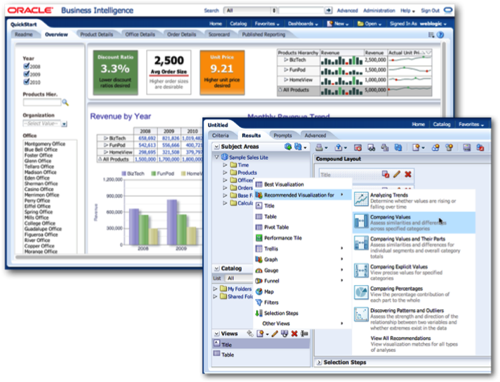
The other major new capability OBIEE 11.1.1.7 brought in was better integration with Essbase and the Hyperion-derived products that are now included in the wider Oracle BI Foundation 11g package. Earlier versions of OBIEE gave you the ability to install Essbase alongside OBIEE11g for the purposes of aggregate persistence into Essbase cubes, but the 11.1.1.7 release brought in a single combined security model for both Essbase and OBIEE, integration of EPM Workspace into the OBIEE environment and the re-introduction of Smartview as OBIEE (and Essbase’s) MS Office integration platform.
Outside of core OBIEE11g but complementing it, and the primary use-case for a lot of OBIEE customers, are the Oracle BI Applications and 2013 saw the release of Oracle BI Applications 11.1.1.7.1, followed just a few days ago by the latest update, OBIA 11.1.1.8.1. What these new releases brought in was the replacement of Informatica PowerCenter by Oracle Data Integrator, and a whole new platform for configuring and running BI Apps ETL jobs based around JEE applications running in WebLogic Server. Whilst at the time of OBIA 11.1.1.7.1’s release most people (including myself) advised caution in using this new release and said most new customers should still use the old 7.9.x release stream - because OBIA 11g skills would be scarce and relatively speaking, it’d have a lot of bugs compared to the more mature 7.9.x stream - in fact I’ve only heard about 11g implementations since then, and they mostly seem to have gone well. OBIA 11.1.1.8.1 came out in early May 2014 and seems to be mostly additional app content, bug fixes and Endeca integration, and there’s still no upgrade path or 11g release for Informatica users, but the 11g release of BI Apps seems to be a known-quantity now and Rittman Mead are getting a few implementations under our belt, too.
Oracle BI Cloud Service (BICS)
So that’s where we are now … but what about the future? As I said earlier, there hasn’t been a major release of OBIEE 11g this year and to my mind, where Oracle’s energy seems to have gone is the “cloud” release of OBIEE11g, previewed back at Oracle Openworld 2013 and due for release in the next few months. You can almost think of this as the “11.1.1.8 release” for this year with the twist being it’s cloud-only, but what’ll be interesting about this version of OBIEE11g is that it’ll probably be updated with new functionality on a much more regular basis than on-premise OBIEE, as Oracle (Cloud) will own the platform and be in a much better position to push-through upgrades and control the environment than for on-premise installs.
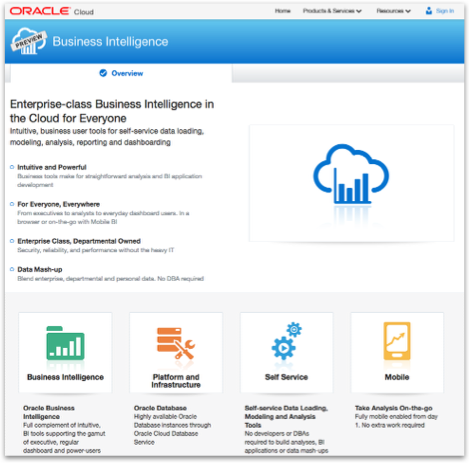
Headline new capabilities in this cloud release will include:
- Rapid provisioning, with environments available “at the swipe of a credit card” and with no need to download and install the software yourself
- Built-in storage, with Oracle’s schema-as-a-service/ApEx database environment backing the product and giving you a place to store data for reporting
- A consumer-style experience, with wizards and other helper features aimed at getting users familiar with on-premise OBIEE11g up and started on this new cloud version
- Access to core OBIEE11g features such as Answers, dashboards, mobile and a web-based repository builder
It’s safe to say that “cloud” is a big deal for Oracle at the moment, and it’s probably got as much focus within the OBIEE development team as Fusion Middleware / Fusion Apps integration had back at the start of OBIEE 11g. Part of this is technology trends going on outside of BI, and OBIEE - customers are moving their IT platforms into the cloud anyway, so it makes sense for your BI to be there too, rather than being the only thing left back on-premise, but a bit part of it is the benefits it gives Oracle, and the OBIEE product team - they can own and control much more of the end-to-end experience, giving them control over quality and much more customers on the latest version, and of course the recurring revenues Oracle gets from selling software-as-a-service in the cloud are valued much higher by the market than the one-off license sales they’ve relied on in the past.
But for customers, too, running BI and OBIEE in the cloud brings quite a few potential benefits - both in terms of Oracle’s official “BI in the Cloud Service”, and the wider set of options when you consider running full OBIEE in a public cloud such as Amazon AWS - see my Collaborate’14 presentation on the topic on Slideshare. There’s none of the hassle and cost of actually setting up the software on your own premises, and then doing upgrades and applying patches over time - “empty calories” that have to be spent but don’t bring any direct benefit to the business. OBIEE in the Cloud also promises to bring a bit of independence to the business from IT, as they’ll be able to spin-up cloud BI instances without having to go through the usual procurement/provisioning cycle, and it’ll be much easier to create temporary or personal-use OBIEE environments for tactical or short-lived work particularly as you’ll only have to license OBIEE for the users and months you actually need it for, rather than buying perpetual licenses which might then sit on the shelf after the immediate need has gone.
Data Visualization, and the Competition from Tableau
It’s probably safe to say that, when OBIEE 11.1.1.3 came out back in 2010, its main competitors were other full-platform, big vendor BI products such as SAP Business Objects and IBM Cognos. Now, in 2014, what we’re hearing anecdotally and from our own sales activity around the product, the main competitor we hear OBIEE 11g coming up against is Tableau. Tableau’s quite a different beast to OBIEE - like QlikTech’s QlikView it’s primarily a desktop BI tool that over the years has been giving some server-based capabilities, but what it does well is get users started fast and give them the ability to create compelling and beautiful data visualisations, without spending days and weeks building an enterprise metadata layer and battling with their IT department.
Of course we all know that as soon as any BI tool gets successful, its inevitable that IT will have to get involved at some point, and you’re going to have to think about enterprise definitions of metrics, common dimensions and so forth, and it’s this area that OBIEE does so well, primarily (in my mind) selling well to the IT department, and with Oracle focusing most of their attention recently on the integration element of the BI world, making it easy to link your ERP and CRM applications to your BI stack, and the whole lot playing well with your corporate security and overall middleware stack. But none of that stuff is important to end users, who want a degree of autonomy from the IT department and something they can use to quickly and painlessly knock-together data visualisations in order to understand the data they’re working with.
So to my mind there’s two aspects to what Tableau does well, that OBIEE needs to have an answer for; ease of setting-up and getting started, and its ability to create data visualisations beyond the standard bar charts and line charts people most associate with OBIEE. And there’s a couple of initiatives already in place, and coming down the line, from Oracle that aim to address this first point; BI Publisher, for example, now gives users the option to create a report directly off-of data in the RPD without the intermediate requirement to create a separate data model, and presents a list of commonly-used report formats at report creation to make the process a bit more “one-stop”.
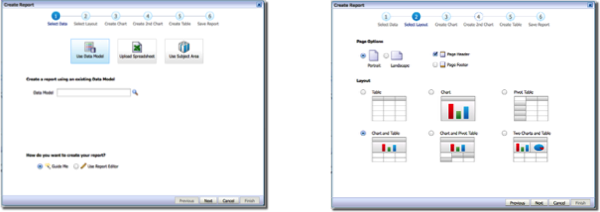
Another initiative that’ll probably come along first as part of the BI in the Cloud Service is personal data-mashups; what this is is a way for users to upload, from spreadsheets or CSV files, data that they want to add to their standard corporate metrics to allow them to produce reports that aren’t currently possible with the standard curated RPD from corporate IT. Metrics users add in this way will have their data stored (probably) in the catalog but marked in a way that it’s clear they’re not “gold-standard” ones, with the aim of the feature being to avoid the situation where users export their base data from OBIEE into Excel and then bring in the additional data there. It does beg a few questions in terms of where the data goes, how it all gets stored and how well it’d work on an on-premise install, but if you work on the basis that users are going to do this sort of thing anyway, it’s best they do it within the overall OBIEE environment than dump it all to Excel and do their worst there (so to speak).
Another even-more intriguing new product capability that’s coming along, and is technically possible with the current 11.1.1.7 release, is the concept of “mini-apps”. Mini-apps are something Philippe Lion’s “SampleApp” team have been working on for a while now, and are extensions to core OBIEE that are enabled via Javascript and allow developers to create self-contained applications, including table creation scripts, to solve a particular user problem or requirement. This Youtube video from one of Philippe’s team goes through the basic concept, with custom Javascript used to unpack a mini-app setup archive and then create tables, and set up the analysis views, to support requirements such as linear regression and trend analysis.
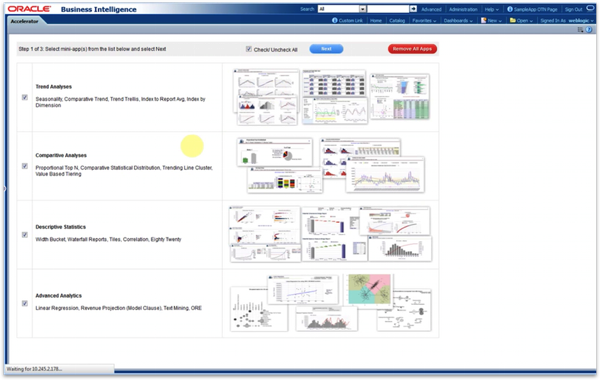
It’s likely the BI Cloud Service will take this concept further and introduce a more formalised way of packaging-up BI mini-applications and deploying them quickly to the cloud, and also maybe introduce the concept of a BI App Store or Marketplace where pre-built analytic solutions can be selected and deployed faster even than if the user tried to built the same themselves using Excel (or Tableau, even).
Of course the other aspect to Tableau is its data visualisation capabilities, and while OBIEE 11.1.1.7 improved in this area a bit - with trellis charts being introduced and a new visualisation suggestion engine - it’s probably fair to say that OBIEE 11g has dropped behind the industry-state-of-the-art in this area. What’s been interesting to see though, over the past twelve months, is the widespread adoption of technologies such as D3 and other third-part visualisation tools as additional ways to add graphs and other visuals to OBIEE, with Accenture’s Kevin McGinley showcasing the art of the possible on his blog recently (parts 1, 2 and 3) and presenting on this topic at the Atlanta Rittman Mead BI Forum later this week. Techniques such as those described by Kevin involve deploying separate third-party visualisation libraries such as D3 and Flot to the WebLogic server running OBIEE, and then calling those libraries using custom code contained within narrative views; while these aren’t as developer-friendly as built-in visualisation features in the tool, they do give you the ability to go beyond the standard graphs and tables provided by OBIEE 11g, as Tom Underhill from our team explained in a blog post on OBIEE11g and D3 back in 2013.
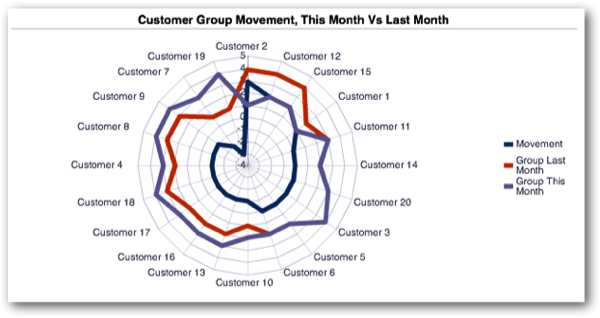
The upcoming 2014 OBIEE11g SampleApp will most probably feature some more third-party and externally-produced visualisations along these lines, including new HTML5 and Javascript integration capabilities for 11.1.1’7’s mapping feature:
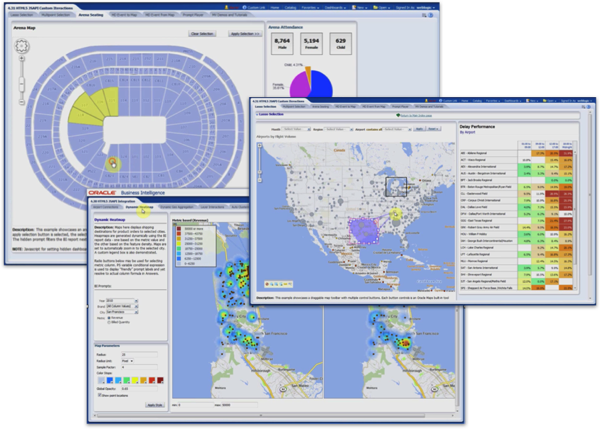
and an example of integration ADF charts - which have far more options and capabilities that the subset used in OBIEE 11g - into the OBIEE dashboard. All of this is possible with OBIEE 11.1.1.7 and standard Jdeveloper/ADF, with the video previewing the SampleApp PoC Demo going through the integration process at the end.
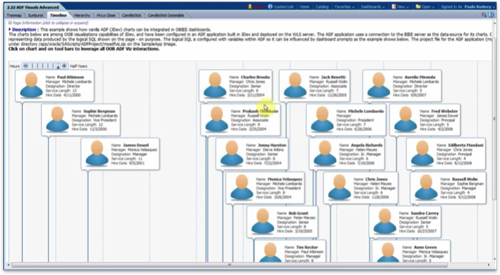
Community Development of OBIEE Best Practices, Techniques, Product Add-Ons
One of the advantages of OBIEE now being a mature and known product is that best practices are starting to emerge around deployment, development, performance optimisation and so-on around the product. For example, our own Stewart Bryson has been putting a lot of thought into agile development and OBIEE, and topics such as automated deployment of OBIEE RPDs using Git and scripting, giving us a more industry-standard way of building and deploying RPDs now that we’ve got the ability to work with repository metadata in a more atomic format. Robin Moffatt, also from Rittman Mead, has published many articles over the past few years on monitoring, measuring and testing OBIEE performance, again giving us a more industry-standard way of regression testing OBIEE reports and monitoring the overall OBIEE experience using open-source tools.
There’s even a third-party add-on industry for OBIEE, with Christian Screen’s / Art of BI’s “BI Teamwork” being the showcase example; OBIEE still doesn’t have any collaboration or social features included in the base product, unless you count wider integration with WebCenter as the answer for this, and Christian’s BI Teamwork product fills this gap by integrating collaboration, social and SaaS integration features into the core product including localisation into key overseas OBIEE markets.
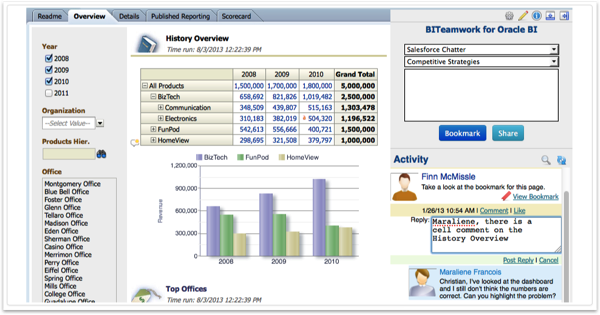
Hadoop and Big Data Integration
You’ll probably have guessed from the amount of coverage we’ve given the topic on the blog over the past few months, but we think Hadoop and big data, and particularly the technologies that will spin-off from this movement, are quite a big deal and will revolutionise what we think-of as analytics and BI over the next few years. Most of this activity has taken place outside the core world of OBIEE using tools such as Cloudera Impala, R and Tableau as the default visualisation tool, but OBIEE will play a role too, primarily through its ability to incorporate big data insights and visualisations into the core enterprise semantic model and corporate dashboards.
What this means in-practice is that OBIEE needs to be able to connect to Hadoop data sources such as Hive and Impala, and also provide a means to incorporate, visualise and explore data from non-traditional sources such as NoSQL and document databases. OBIEE 11.1.1.7 made a first step in this direction with its ability to use Apache Hive as a datasource, but this really is a minimal step-one in support for big data sources, as Hive is generally considered too-slow for ad-hoc query use and the HiveServer1 ODBC driver OBIEE 11.1.1.7 ships with no longer being compatible with recent Cloudera Hadoop (CDH 4.5+) releases. What’s really needed is support for Impala - an in-memory version of Hive - as a datasource, something we hacked-together with a workaround but most probably coming as a supported data source in a future version of OBIEE. What would be very interesting though is support for document-style databases such as MongoDB, giving OBIEE (or most probably, Endeca) the capability to create 360 degree-views of customer activity, including unstructured data held in these NoSQL-style databases.
Exalytics and Engineered Systems
I’d almost forgotten Exalytics from this round-up, which is ironic given its prominence in Oracle BI product marketing over the past couple of years, but not all that surprising given the lack of real innovation around the product recently. There’s certainly been a number of Exalytics updates in terms of product certification - the graphic below shows the software evolution of Exalytics since launch, going up to autumn last year when we presented on it at Enkitec E4:
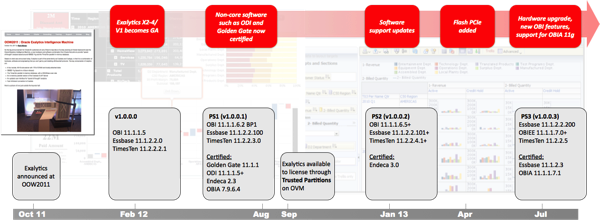
whilst the Exalytics hardware over the same period has seen RAM double, and SSD disk added to improve TimesTen and Essbase startup-times.
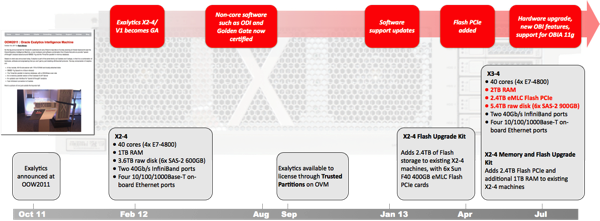
What Exalytics has lacked, though, is something game-changing that’s only available as part of this platform. There’s a central dilemma for Oracle over Exalytics; do they develop something for OBIEE that only works on OBIEE, that’s substantial and that they hold-back from the on-premise version, or do they largely release the same software for both Exalytics, and non-Exalytics OBIEE and rely on performance tweaks which are hard to quantify for customers, and are hard for Oracle salespeople to use as differentiation for the product. So far they’ve gone for the latter option, making Exalytics - if we’re honest - a bit underwhelming for the moment, but what would be really interesting is some capability that clearly can only be supported on Exalytics - some form of in-memory analysis or processing that needs 1TB+ of RAM for enterprise datasets, possibly based on an as-yet unreleased new analytic engine, maybe based on Essbase or Oracle R technology, maybe even incorporating something from Endeca (or even - left-field - something based on Apache Spark?)
My money however is on this differentiation growing over time, and Exalytics being used extensively by Oracle to power their BI in the Cloud Service, with less emphasis over time on on-premise sales of the products and more on “powered by Exalytics” cloud services. All of that said, my line with customers when talking about Exalytics has always been - you’re spending X million $/£ on OBIEE and the BI Apps, you might as well run it on the hardware its designed for, and which in the scheme of things is only a small proportion of the overall cost; the performance difference might not be noticeable now, but over time OBIEE will be more-and-more optimised for this platform, so you might as well be on it now and also take advantage of the manageability / TCO benefits.
So anyway, that’s my “state-of-the-nation” for OBIEE as I see it today - and if you’re coming along to the Atlanta RM BI Forum event later this week, there’ll be futures stuff from Oracle that we can’t really discuss on here, beyond the 3-6 month timeline, that’ll give you a greater insight into what’s coming in late 2014 and beyond.